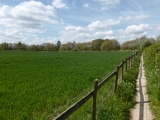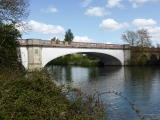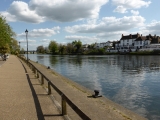Windsor to Chertsey
Tuesday 18 April 2017

Day Eleven did not get off to the easiest of starts as circumstances beyond our control forced us to start off much later than usual, not leaving Windsor until almost lunchtime. That turned out to be a blessing in disguise in a way, as we were due to be staying with another Airbnb host that evening and his work schedule meant that we could not check in until at least 6.00 pm anyway. The late start therefore enabled us to arrive at around the right time rather than having several hours to wait around, as well as giving us a chance early in the morning to take some photos of Windsor Castle free from the many tourists who had been there when we arrived the previous day.
Taking us to within fifty miles of the Thames Barrier, this was arguably the last day on the trip which would see us passing through what could be described as a 'rural' area. Although it would be another day until we actually passed into the area of the Greater London Authority, much of this section was definitely the beginnings of the London suburbs and after the first few miles, there were near continuous settlements all along the river.
When we finally did head away from Windsor, it was on a warm sunny morning with the strongest heat of the day already approaching, something which we had done our best to avoid during the trip. After picking up the path again by the Windsor Town Bridge, we first headed past Romney Lock and under the bridge which carries the railway towards London, before passing around the edge of the Home Park with its numerous sports pitches and views back towards Windsor Castle. As the Victoria Bridge came into view ahead, we branched away from the river to meet up with the B470 road and then crossed the Thames heading towards Datchet. Although the path initially leaves the road behind, we did soon meet up with it again for a short section of road walking through Datchet, thankfully the only section away from the river all day.
Just after leaving Datchet, we turned away from the road again and walked along two edges of a field to meet up with the Thames again, soon crossing back to the southern bank via the Albert Bridge. As a result of our late start it was already lunchtime so we soon stopped to eat, our break being accompanied by a single boat on the river which for some reason kept turning in circles near to us before heading off back in the direction it had come from. Restarting after lunch, we quickly came to another 'short cut' provided by a new cut in the river, to the south-west of Ham Island, before rejoining the main channel at Old Windsor Lock. The section past Old Windsor, which lost the name of 'Windsor' to the settlement which grew up around the castle, is characterised by housing along both banks before emerging alongside the A308 near to Runnymede.
Signalling our arrival in Surrey for the first time, Runnymede is famous as the site where Magna Carta ('great charter') was agreed between King John and rebel barons in 1215 and there is now a memorial on the far side (as seen from the river) of the meadow there. Created by the American Bar Association in 1957, visiting the memorial required a slight detour from the path and I decided to make the journey, while my girlfriend took the opportunity of another break alongside the river. On the way, I also passed a much more recent memorial unveiled by Queen Elizabeth II on the occasion of Magna Carta's 800th anniversary in 2015.
Returning from the detour, we headed along past a statue of the queen before reaching another clear sign of the approach to London, the M25. At this point the Thames Path passes under no fewer than four bridges, which between them carry both the A30 and the considerably wider motorway across the river. After passing under the bridges, we were soon greeted by the less than scenic water treatment works at Egham. Here the view is much better looking across to the northern bank, where a great many trees give the river a considerably less urban feel. The next landmark to come into view is Staines Bridge, where we crossed the Thames once again into what used to be Middlesex, but now like the southern bank is part of Surrey.
Having arrived in Staines, we began the longest section of urban walking that we had so far encountered. Happily, apart from one brief turn away from the Thames the path stays alongside the river, passing mostly residential areas. By this stage the heat of the day was beginning to pass as the early evening started to approach, with the weather thankfully getting a little cooler by the time we stopped for another short rest on a bench near to St Peter's Church. As the river heads away from Staines, it turns sharply to the left before eventually passing Penton Hook Lock, opened in 1815 to cut the corner of a very sharp meander in the Thames which now makes up Penton Hook Island.
Eventually Staines gives way to the adjoining village of Laleham, after which the path leaves behind the old towpath which it had been following and runs alongside the road all the way to Chertsey. Thankfully, it is not proper road-side walking along this stretch as although there is no pavement, there is room to walk along the outside of the fence on the grass between the road and the river. As Chertsey approached, we passed under a motorway for the second time in the day as the M3 crossed the river, shortly before Chertsey Bridge came into view in the distance. After walking under the Bridge, we headed up to the main road where faced with another mile or more walking to our accommodation, we decided to end Day Eleven with a short taxi ride.

























